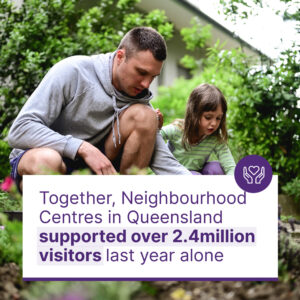Media release
Wednesday 15 May
Now more than ever before, Queenslanders are turning to local Neighbourhood Centres for support and connection when impacted by disasters, stressors associated with the soaring cost of living and for help keeping a roof over their head in the face of the housing crisis.
The annual Neighbourhood Centres Queensland (NCQ) Neighbourhood Centre Sector Impact Report released today found the number of visitors to Neighbourhood Centres over the year has increased to 2.4million, up from 2 million the year before.
In the last year alone, the 155 Neighbourhood Centres spread across Queensland saw demand for a wide range of supports increase, including:
- Emergency food relief increased to a total of 1,285 tonnes for the year, equating to a median amount of 720kg distributed per Centre per month
- Non-food emergency relief (such as clothes and fuel vouchers) increased to $3.85million
- The number of referrals to specialist services increased to 299,800
- Participants in programmed activities increased to 1,193,350
NCQ Interim CEO, Chris Mundy said the significant increases in people seeking support shows communities are doing it tough and the place-based, community-led work of Neighbourhood Centres are vital. But Centres need increased government funding to keep up with demand.
“Neighbourhood Centres are embedded in their local communities and respond to the unique challenges faced by each community by building relationships and tailoring supports. That’s what makes them so effective in the way they respond to community challenges. For example, remote communities can have very different needs to communities in cities and it’s the local wisdom and relationships of Neighbourhood Centre staff that can make all the difference.”
“Whether it be food relief, housing support, fuel vouchers, budget assistance as well as information, referrals, counselling, domestic violence support or tailor-made local programs, Centres are on the frontline offering a helping hand in their community. They are often the first place people go to seek support when times are tough,” Mr Mundy said.
Despite the increasing need for community support, Queensland has less funded Neighbourhood Centres than any other state in mainland Australia.
Out of a total of 155 Neighbourhood Centres across the state, only 128 receive Neighbourhood Centre Program funding, leaving 27 without financial support.
Today, during national Neighbourhood Centre Week, the peak body and the sector is calling on the Queensland Government to invest a further $7.371million in the expansion, training and support of the sector across the state as it undergoes increasing pressure.
“Neighbourhood Centres are providing place-based community-led solutions to a wide range of social challenges, but this sector needs appropriate investment”, stated Mr Mundy.
“Because Neighbourhood Centres are experiencing such a substantial increase in community demand, even with the increase in funding in 2022, the data shows adequate funding and recognition of Neighbourhood Centres remain crucial issues. Rising populations and increasing social challenges place greater strain on each Centre,” said Mr Mundy.
The argument for increased funding is substantiated, with the NCQ Sector Impact Report demonstrating for every $1 invested by the Queensland Government, the sector produces $4.09 in Community Value.
The report’s finding that Neighbourhood Centres are distributing 720kg of emergency food relief per Centre per month is a substantial increase from the year before, which saw Centres distributing an average of 375kg per Centre per month. This also represents sevenfold increase from the100kg per Centre per month being distributed in 2019.
“These high levels of emergency relief indicate that Centres are on the frontline of the cost-of-living crisis.” Mr Mundy said.
“Queensland is the most disaster affected state in Australia. We know locally-led disaster response is effective, and we know 64% of Neighbourhood Centres now offer disaster preparedness, response and recovery supports.” Mr Mundy said.
“We’re asking the state government to fund the operations of at minimum 10 additional Neighbourhood Centres across the state,” Mr Mundy said.
“Some communities are missing out and we want to see more Neighbourhood Centres funded across the state. 128 is not enough Centres in a state with a population of almost five and a half million people, and it definitely won’t be enough as the population and the need increases,” Mr Mundy said.
Neighbourhood Centres also run community activities and are reducing social isolation and loneliness for community members across Queensland.
“Social isolation and loneliness is widespread across the state. Neighbourhood Centres are responding to this. Whether it be intergenerational playgroups, community transport, support groups, adult education programs or volunteering, Centres are providing an opportunity for social connection which people may not otherwise have access to.” Mr Mundy said.
The annual Neighbourhood Centre Sector Impact Report captures key data and insights from the largest Queensland-wide census of the Neighbourhood Centre sector.
ENDS.
Neighbourhood Centres Queensland (NCQ) is the peak body for Neighbourhood Centres in Queensland. With over 150 Neighbourhood Centres across the state, our sector represents the largest community-led infrastructure in Queensland. NCQ is here to grow our collective impact by increasing the resourcing, recognition, and relationships of Neighbourhood Centres at the local, state, and national level. We collaborate with our members, partners and government to measure impact and build sector capacity for long-term community and social resilience.
Media enquiries
If you are interested in more information about the 2023 Sector Impact Report or the work of Neighbourhood Centres in Queensland, please contact Melanie Maher: 0423 192 862, .
2023 Sector Impact Report: https://bit.ly/SIR-webpage
